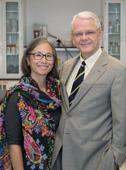Surgery Chair Invests
in Future of Surgeon –
Scientists

Jim and Mari Rutka
(Photo by Dan
Haves)
|
A surgeon needs strong
technical skills, first and
foremost. But that’s not
enough.
“We’re treating surgical
conditions and diseases
that we don’t have
all the answers for yet
— cancers that evade
our best efforts at surgery,
and organs that fail
and require regeneration
or replacement,” says
U of T Department of Surgery Chair and SickKids
Neurosurgeon James Rutka. “We need to untangle the
complexity of these diseases through research, and use
new insights to advance clinical care.”
At the forefront of this effort is the Department’s
world-renowned Surgeon Scientist Training Program
(SSTP) — a unique program that enables all surgical
residents to pursue research at the Master’s or PhD level,
in addition to their surgical training.
Launched in 1985 by leading surgeon and then
Department Chair Professor Emeritus Bernard Langer,
the SSTP was the first of its kind, and remains one of the
best surgical training programs in the world. It has led
to major advances in procedures, and trained many of
today’s top Surgeon Scientists. It was here that Professor
Shaf Keshavjee began his work in the hugely successful
ex-vivo lung transplantation. It was here — and in
Rutka’s own research lab — that Professor Peter Dirks
began investigations that ultimately led to his uncovering
the role stem cells play in human brain cancers. He is
now advancing this work as lead researcher of the $11.7
million Stand Up To Cancer initiative.
“Some of my greatest pride is having trained surgeons
who have far surpassed me,” says Rutka, who is also
Director of the Arthur and Sonia Labatt Brain Tumour
Research Centre, where he continues to oversee SSTP
trainees. In addition to Dirks, his former trainees include
Professors Michael Taylor, Todd Mainprize, and Paul
Kongkham, all of whom have made key discoveries leading
to more targeted therapies for brain cancers. Rutka’s
own research into the molecular pathways involved in
malignant tumor growth and invasion is informing the
development of potential new treatments.
|
As Department Chair and a Surgeon-Scientist himself,
Rutka is deeply committed to the SSTP. Now he
is building on this commitment as a philanthropist.
Through a joint commitment from the Rutka family,
SickKids Foundation, and the University of Toronto,
the James and Mari Rutka Surgeon Scientist Training
Fund will be established in the Department of Surgery.
It will invest $3 million in the program, helping ensure
it remains open to all surgical trainees and continues to
enhance health care into the future.
“As a family, we really wanted to invest in this program
and we know it will reap huge benefits for decades
to come,” says Rutka. “It’s becoming very difficult now
for investigators to obtain research funding. Accordingly,
we rely on philanthropy more than ever to keep us at
the cutting edge, and to maintain us as world leaders in
scientific research.”
“As we face cuts to research funding, the Surgeon
Scientist Training Program is one of those programs that
is just too important to lose,” says Faculty of Medicine
Dean Trevor Young.
“As a clinician scientist, I know how valuable this
research training is in improving the care we offer. Not
only has Jim been a leading Surgeon Scientist — combining
his career as a neurosurgeon at SickKids with
studying the dynamics involved in the most challenging
diseases — he has also been a valuable academic leader.
And now he and Mari are investing in the future of surgery
as philanthropists — what a profound and tangible
commitment of support.”
This investment in the future is key for the Rutkas.
“People get so tied up in the present,” says Mari Rutka.
“But if we want to truly leave a legacy, we have to start
building the future now.”
Carolyn Morris,
Senior Advancement
Communications Officer
Office of Communications, Faculty of Medicine,
University of Toronto
[EDITOR’S NOTE:
Our recent 5 year External Review of the Department of
Surgery highlighted an important issue. External funding
for the SSTP has diminished, while the number of residents
enrolled continues to increase. The Rutkas are leading us
toward a solution. Their example inspires us to join them
with annual contributions to sustain the signature academic
program of our Department.]
|